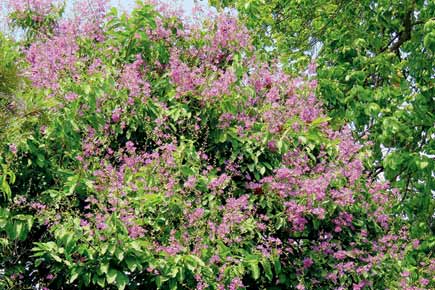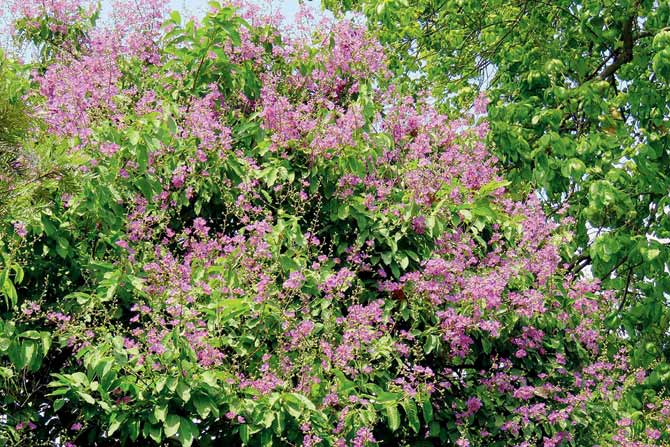We Indians are filled with national and regional fervour, sometimes even to the detriment of civil society. However, if you ask me, the true sign of patriotism is appreciating and upholding the status granted to our respective state trees and flowers by opting to grow them in every state and central government office, school, hospital and public ground.

Mumbai is home to the brilliantly colourful state flower of Maharashtra, Tamhan, also known as Jarul, Crepe Myrtle and Queen's flower. pics/Anand Pendharkar
 We Indians are filled with national and regional fervour, sometimes even to the detriment of civil society. However, if you ask me, the true sign of patriotism is appreciating and upholding the status granted to our respective state trees and flowers by opting to grow them in every state and central government office, school, hospital and public ground. These state trees and flowers thrive in regional climates and are excellent representatives of the region. Hence, not only do they provide shade and decorate our avenues or streets, but they are also the best natural habitats for indigenous animal species.
We Indians are filled with national and regional fervour, sometimes even to the detriment of civil society. However, if you ask me, the true sign of patriotism is appreciating and upholding the status granted to our respective state trees and flowers by opting to grow them in every state and central government office, school, hospital and public ground. These state trees and flowers thrive in regional climates and are excellent representatives of the region. Hence, not only do they provide shade and decorate our avenues or streets, but they are also the best natural habitats for indigenous animal species.
ADVERTISEMENT

Mumbai is home to the brilliantly colourful state flower of Maharashtra, Tamhan, also known as Jarul, Crepe Myrtle and Queen’s flower. Pics/Anand Pendharkar
However, in spite of all that patriotism, we Indians are shockingly obsessed with exotic trees and their colourful flowers, just as our former rulers were. They came from varied continents and brought along with them various non-local and ecologically useless trees such as Gulmohar, Frangipani (Champa), Spathodea (Bell Tulip), Canonball, Tabebuia, Gliricidia, Silver Oak, and to some extent the Raintree and False Ashoka (Mast) trees, to simply decorate or remind them of their ancestral homes. Thus, an old business hub like Bombay (Mumbai) was crowded with a grand mixture of local and newly-introduced tree species.
I’m sure we all have our favourite trees, irrespective of whether they are indigenous or exotics. But anybody who lays their eyes on the brilliantly colourful state flower of Maharashtra, Tamhan, also known as Jarul, Crepe Myrtle and Queen’s flower, will inevitably fall in love with the trees on which they grow. And luckily, even the highly urbanised city of Mumbai and its suburbs are home to hundreds of these elegant, flowering trees. If you drive past the Western Express Highway, near the Vakola signal or the lane leading to New Excelsior Theatre, from CST Station or enter the Byculla Zoo (Ranibaug) campus, during the summer, from April to June, the resplendent, dense, terminal panicles (clusters) of the Queen’s Flower will simply take your breath away.
The Taman tree is an uncommon, medium-sized deciduous tree found in the dry and moist deciduous forests of India, Sri Lanka, Myanmar, Vietnam, Thailand, Indonesia and Philippines. The Hindi name Jarul, roughly translates into ‘Queen of flowers’, and its Sanskrit name Syandana finds mention in the Ramayana. However, the modern, scientific classification provided by Carl Linnaeus, Lagerstroemia flos-reginae was in honour of his friend Carl Magnus von Lagerstrom, the Swedish East India Company Director, and the species name ‘flos-reginae’ means Queen of flowers in Latin.
Taman is also planted as an avenue tree due to its dozens of medicinal and economic uses. In Philippines, Taman is popularly called Banaba. Here, its dried and shredded leaves are drunk as a decoction or tea, which helps control Type 2 Diabetes. The wood is hardy and resistant to termites. Jarul wood, dating back to 7,500 years, has been found staying resistant to decay. The flaky bark’s leaves and star shaped woody fruits are used to produce tannins for dyeing. A decoction of the bark is also used to cure diarrhea and abdominal pain and extracts of leaves are used to treat malaria. Taman seeds are in great demand as they yield valuable oil.
The tree is also highly coveted in cities or grown along barren or riverine areas, due to its deep roots which control soil erosion. The dense canopy of leaves provide shelter and shade as well as nesting grounds for squirrels, civets, owls, crows and many other creatures. So, let’s ensure that this coming monsoon, you will gather proud Maharashtrians, neighbours, family and friends and plant at least half a dozen of these regal beauties to adorn your office, home, school or even your favourite mall and exhibit your state pride in the most ecologically appropriate manner.
Anand Pendharkar is an ecologist and the founder of SPROUTS, an outdoors and eco-tourism company and SPROUTS Environment Trust, an NGO which works with youth and underprivileged groups and aims to provide a sustainable environment for all
 Subscribe today by clicking the link and stay updated with the latest news!" Click here!
Subscribe today by clicking the link and stay updated with the latest news!" Click here!






